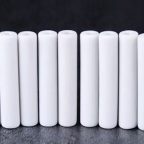Zirconia ceramic plastic clay mass is a plastic-viscous system composed of solid phase, liquid phase and gas phase, and is composed of powder, binder, plasticizer and solvent. The important difference between zirconia ceramic plastic clay mass and slurry is the difference in solid-liquid ratio. The water content of zirconia ceramic plastic mud is generally 19% to 26%, while the water content of the slurry is as high as 30% to 35%. There are two forces between the particles of the mud mass:
- Suction, mainly van der Waals force, electrostatic attraction and capillary force. The suction range is about 2nm. The capillary force is the main source of the gravitational force between the particles of the mud mass.
- Repulsion, in water medium, the range of repulsion is about 20nm. When the water content in the system is high and the particles are far apart, the repulsion is dominant. When the water content is low, the particles are close together, showing that the suction is dominant, and it becomes a mud mass.
The plastic molding of zirconia ceramics requires a certain plasticity of the mud mass. The so-called plasticity of zirconia ceramics refers to the ability of the aggregate to generate strain under the action of external force and retain this deformation after removing the external force. If a mud mass is easily deformed under the action of external force, and the deformation is basically retained after the external force is removed, we say that this zirconia ceramic mud mass has good plasticity. When the force is very small, the stress σ and the ε strain account for a linear relationship, and the deformation is reversible. This elastic deformation is mainly caused by the presence of a small amount of air and organic plasticizers in the mud mass. Irreversible pseudoplastic deformation occurs if the stress exceeds the mine. It is called the flow limit or yield limit. After the stress exceeds σγ, the mud mass has plastic properties.
After the stress is removed, the remaining γη of the strain εγ can only be partially recovered. is the irreversible part. If the re-applied stress exceeds σρ, the mud mass will crack and fail. When the strain value at this time is ερ, it is desirable that the mud mass maintain a plastic state for a long time. The formation of a plastic state is favored if the pressure is applied slowly and repeatedly to the mud mass. There are two parameters that are important for the formation of the mud mass, one is the yield limit σρ and the other is the deformation amount of ερ cracks. It is desirable for the zirconia ceramic mud to have a high yield limit to prevent deformation caused by accidental external forces. It is also desirable to have a sufficient amount of rupture deformation so that no cracks appear during the forming process. “σγχερ” is often used to evaluate the forming ability of mud mass. Different plastic forming methods have different requirements for these two parameters. Extrusion and {strip forming requirements are higher in order to stabilize the shape of the green body. Spin forming or roll forming can be smaller. The main factors affecting the plasticity of mud mass are:
- The properties and composition of zirconia ceramic raw materials. Generally speaking, the zirconia ceramic raw material itself is a factor that cannot be changed. The raw materials with strong cation exchange force can, on the one hand, form a water film on the surface of the zirconia ceramic particles and increase the plasticity; Decreasing the particle size and increasing the specific surface area can also increase the cation exchange capacity. At the same time, the fine-grained raw materials require a large amount of water and a large capillary force to form a water film. These are the reasons for the good plasticity of the fine-grained mud mass. The finer the clay particle size and the more water content, the better the workability.
- The effect of adsorbed ions on zirconia ceramics. Considering the valence of the adsorbed cations, the trivalent cation has a high valence, and the negatively charged particles have a strong attraction. Most of them enter the adsorption layer of the micelle, and the charge of the whole micelle is low, so the repulsion force is reduced and the attractive force is reduced. increase, so the plasticity of the mud mass increases. Divalent cations are next, and monovalent cations are the smallest. Among monovalent cations, hydrogen is an exception. Because it’s actually an atomic nucleus, it has the highest charge density, the greatest attraction, and therefore the greatest plasticity. When the raw material particles adsorb different cations, the order of plasticity and the order of cation exchange are the same: H+>A13+>Ba2>ca2>Mg2>NH2>K+>Na+>Li+
- The influence of zirconia ceramic solvent. The most commonly used solvent (dispersion medium) is water. Only when it contains the proper amount of moisture, the mud mass has the greatest plasticity. Generally speaking, the plasticity of the mud mass is the highest when the water film thickness is 0.2 mm.
Pintejin machining ceramic service include : Alumina Ceramic Parts, Zirconia Ceramic, Silicon Carbide Ceramic, CNC Machined Aluminum Nitride Ceramic, Machinable Ceramic Parts, Glass Ceramic,Macor Ceramic,Powder Metallurgy Dies,Ceramic Injection Molding,Ceramic Dry Pressing,Ceramic Extrusion Dies




